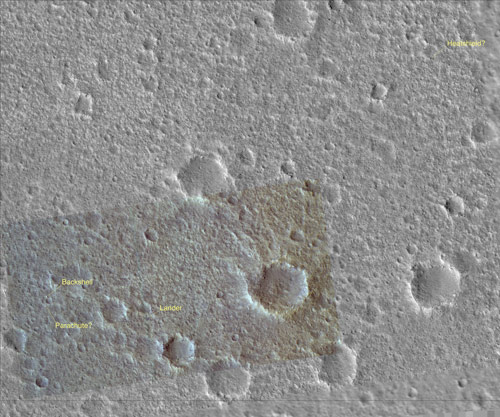|
|
 |
| Press Release Images |
 |
| Return to Press Release Images index |

|
|
Full Res JPG (3.76 MB)
|
Hi-Res (NASA's Planetary Photojournal)
NASA's Viking Lander 1 touched down in western Chryse Planitia on July 20, 1976. The lander, which has a diameter of about 3 meters (10 feet), has been precisely located in this image from the High Resolution Imaging Science Experiment camera on NASA's Mars Reconnaissance Orbiter. Also, likely locations have been found for the heat shield, back shell, and parachute attached to the back shell. The lander location has been confirmed by overlaying the lander-derived topographic contours on the high-resolution camera's image, which provides an excellent match. Viking Lander 1 was one element of an ambitious mission to study Mars, with a four-spacecraft flotilla consisting of two orbiters and two landers. Four cutouts from this image are shown. The first is an overview showing the relative locations of the lander and candidate back shell and heat shield, and the others are enlargements of each of these components. Large boulders, dunes, and other features visible in Lander images can be located in the image.
A prime motivation for early viewing of these Viking sites is to calibrate imagery taken from orbit with the data previously acquired by the landers. In particular, determining what sizes of rocks can be seen from Mars Reconnaissance Orbiter aids the interpretation of data now being taken to characterize sites for future landers, such as the Phoenix Mars Lander mission to be launched in 2007.
|
JPL Image Use Policy
|